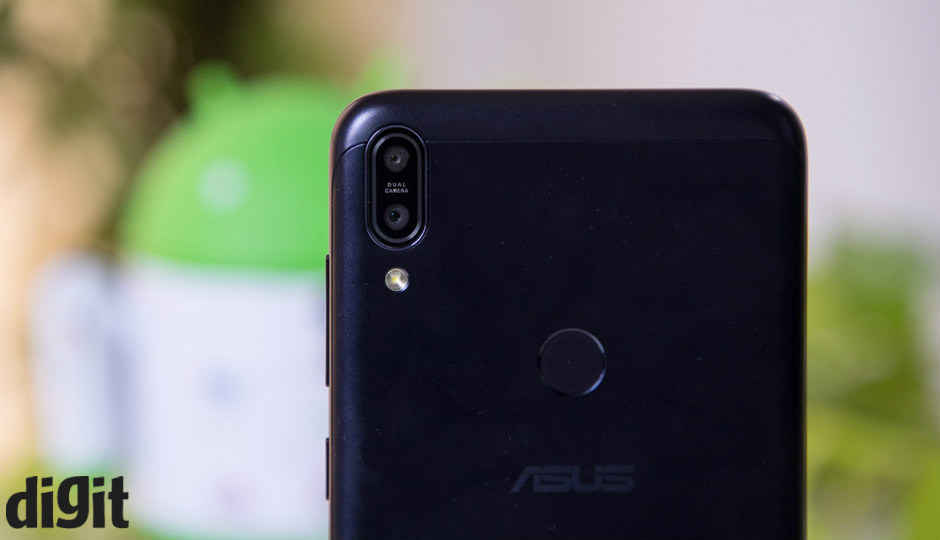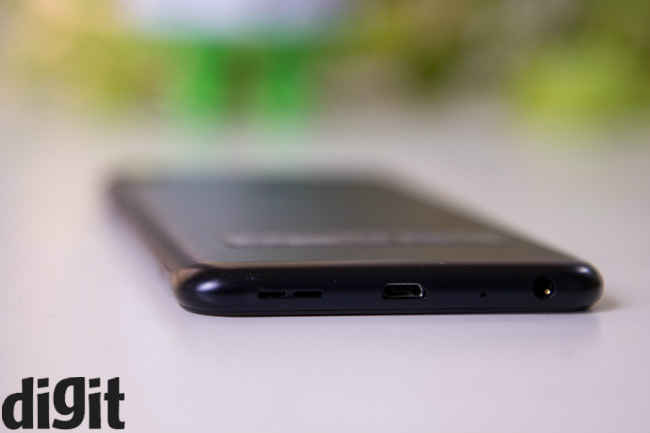
Our Verdict
The Asus Zenfone Max Pro can take on the best in the market with ease. Like most Asus phones, the spec-sheet is maxed out with the best mid-range hardware. That includes latest stock Android and a 5,000mAh battery, two features which solve the biggest pain points people tend to have when making a purchase at that price range. The phone even manages to take on the formidable Redmi Note 5 Pro, save for the imaging prowess, but the pros easily outweigh the cons. In all, it’s always good to have a choice of clean stock UI without compromising on the performance.
PROS
- Latest stock Android 8.1 Oreo out of the box
- Two-day long battery
CONS
- Shoddy camera
- Generic design
Asus Zenfone Max Pro M1 64GB: Detailed Review
The mid-range market is now dominated by Xiaomi. There’s one Redmi phone for every price point in that segment and the consumer is essentially spoilt for choice. However, Redmi phones are notorious for getting sold out in seconds. Getting your hands on one is a matter of pure luck. But then again, we have always recommended our readers to wait and try their luck because no other phonemaker has been able to match up to the quality Xiaomi assures in its products. That is, until now.
The Asus Zenfone Max Pro is a breath of fresh air in a market that is otherwise inundated with Xiaomi phones. Asus’ offering matches Xiaomi’s most premium mid-range offering feature-by-feature and for the most part, can be considered an equal. Except, the Max Pro runs on stock Android UI while the Redmi Note 5 Pro is of course powered by MIUI. There’s nothing wrong with using MIUI, but there’s a certain simplicity and comfort in using stock Android. It’s familiar to anyone who has used an Android device and is efficient enough to not tax the processor. Considering how the UI is the most frequent aspect of the phone a user will interact with, it counts a lot, and in this case, Asus’ choice makes the Zenfone Max Pro a force to reckon with. What’s better is that the phone is much cheaper than the Redmi Note 5 Pro and will be available more easily than the Redmi Note 5 Pro.

The question then remains, did Asus finally crack the formula to make a reliable mid-range phone? With the Zenfone Max Pro, it certainly seems so. It has everything you can ask for at the price — The latest mid-range chipset, tall 18:9 display, dual cameras and a massive 5,000mAh battery. In this review, we find out whether all the features work as advertised, and more importantly, does it make sense to buy this over the Redmi Note 5 Pro? Read on.
Design
Taller displays aren’t new anymore and neither is the metal unibody design most mid-range smartphones like to sport. The Zenfone Max Pro is yet another iteration of the same design philosophy. The display takes up most of the real estate up front while at the back the dual camera module is vertically aligned at the top left corner. The fingerprint sensor is conveniently placed in the center where the finger can easily reach it. The form factor with a thinner display is naturally ergonomic and the rounded corners makes the phone sit plush in the hand.

Like most other mid-range phones, the Zenfone Max Pro also deploys a 2.5D curved glass that bends ever so slightly to meet the metal frame. Asus has polished the rear plate to give a soft matte finish that does tend to get dirty when used with sweaty hands but isn’t a fingerprint magnet. There are two colour variants to choose from — Meteor Silver and Deepsea Black. Both look equally good and you’ll be hard pressed to make a choice. There’s colour-matched polycarbonate antenna lines to enhance network reception.

I particularly liked the fact that the dual camera module is flush with the body and there’s no camera bump, which has become an eyesore in most smartphones. There’s also no need to make a choice between a second SIM card and a microSD card as the phone houses dedicated slots for all three. In the mid-range market, that counts as a lot since most users tend to use a secondary SIM card and rely on expanded storage.
The design of the Zenfone Max Pro isn’t going to get points for being innovative, but it does comes across as well-built and functional. The added heft, thanks to the massive 5,000mAh battery provides a good grip and the minimalist body makes the display the center of attraction.
Display
The Zenfone Max Pro could have been easily lost in a sea of smartphones with an 18:9 display, if not for the superior quality of the panel. Like most other mid-rangers, this too relies on a 6-inch FHD+ IPS LCD panel, housed in a 5.5-inch body. While the idea isn’t as innovative as before, the usefulness remains. There’s less scrolling while browsing the web, while gaming on the widescreen allows for easier controls. Split-screen on the display is particularly useful as the screen gets divided into two equal halves.
For bedtime use, Asus offers a blue-light filter as well as a slider to adjust the colour temperature.

Asus claims to have used Qualcomm’s TruPallette and Ecopix display technology to render a higher contrast ratio of 1500:1, which shows when you watch something on the screen. The blues and the greens look saturated with high contrast while skin tones are made more accurate. It’s still no match for an AMOLED panel though in terms of contrast ratios, but the colour are more vibrant than its closest competitor — The Redmi Note 5 Pro.
Performance and UI
Asus’ choice of using the latest hardware and stock Android will keep this phone in the limelight for some time to come. The Zenfone Max Pro is powered by the Snapdragon 636 chipset, the one introduced by Xiaomi’s Redmi Note 5 Pro in the mid-range segment which effectively blew the competition away.
The 14nm chipset builds on top of the popular and reliable Snapdragon 625, offering a 50 percent jump in performance over its predecessor. That’s possible even after the max clock speed has been reduced to 1.8GHz from 2.0GHz in the SD625. It’s because the SD636 uses Qualcomm’s custom Kryo cores which is also used in the flagship 8-series chipsets, allowing the CPU to provide more power for longer without compromising on battery efficiency.
ASUS ZENFONE MAX PRO M1 64GB RATING 78100
Our Verdict
The Asus Zenfone Max Pro can take on the best in the market with ease. Like most Asus phones, the spec-sheet is maxed out with the best mid-range hardware. That includes latest stock Android and a 5,000mAh battery, two features which solve the biggest pain points people tend to have when making a purchase at that price range. The phone even manages to take on the formidable Redmi Note 5 Pro, save for the imaging prowess, but the pros easily outweigh the cons. In all, it’s always good to have a choice of clean stock UI without compromising on the performance.
PROS
- Latest stock Android 8.1 Oreo out of the box
- Two-day long battery
CONS
- Shoddy camera
- Generic design
Asus Zenfone Max Pro M1 64GB: Detailed Review
The mid-range market is now dominated by Xiaomi. There’s one Redmi phone for every price point in that segment and the consumer is essentially spoilt for choice. However, Redmi phones are notorious for getting sold out in seconds. Getting your hands on one is a matter of pure luck. But then again, we have always recommended our readers to wait and try their luck because no other phonemaker has been able to match up to the quality Xiaomi assures in its products. That is, until now.
The Asus Zenfone Max Pro is a breath of fresh air in a market that is otherwise inundated with Xiaomi phones. Asus’ offering matches Xiaomi’s most premium mid-range offering feature-by-feature and for the most part, can be considered an equal. Except, the Max Pro runs on stock Android UI while the Redmi Note 5 Pro is of course powered by MIUI. There’s nothing wrong with using MIUI, but there’s a certain simplicity and comfort in using stock Android. It’s familiar to anyone who has used an Android device and is efficient enough to not tax the processor. Considering how the UI is the most frequent aspect of the phone a user will interact with, it counts a lot, and in this case, Asus’ choice makes the Zenfone Max Pro a force to reckon with. What’s better is that the phone is much cheaper than the Redmi Note 5 Pro and will be available more easily than the Redmi Note 5 Pro.

The question then remains, did Asus finally crack the formula to make a reliable mid-range phone? With the Zenfone Max Pro, it certainly seems so. It has everything you can ask for at the price — The latest mid-range chipset, tall 18:9 display, dual cameras and a massive 5,000mAh battery. In this review, we find out whether all the features work as advertised, and more importantly, does it make sense to buy this over the Redmi Note 5 Pro? Read on.
Design
Taller displays aren’t new anymore and neither is the metal unibody design most mid-range smartphones like to sport. The Zenfone Max Pro is yet another iteration of the same design philosophy. The display takes up most of the real estate up front while at the back the dual camera module is vertically aligned at the top left corner. The fingerprint sensor is conveniently placed in the center where the finger can easily reach it. The form factor with a thinner display is naturally ergonomic and the rounded corners makes the phone sit plush in the hand.

Like most other mid-range phones, the Zenfone Max Pro also deploys a 2.5D curved glass that bends ever so slightly to meet the metal frame. Asus has polished the rear plate to give a soft matte finish that does tend to get dirty when used with sweaty hands but isn’t a fingerprint magnet. There are two colour variants to choose from — Meteor Silver and Deepsea Black. Both look equally good and you’ll be hard pressed to make a choice. There’s colour-matched polycarbonate antenna lines to enhance network reception.

I particularly liked the fact that the dual camera module is flush with the body and there’s no camera bump, which has become an eyesore in most smartphones. There’s also no need to make a choice between a second SIM card and a microSD card as the phone houses dedicated slots for all three. In the mid-range market, that counts as a lot since most users tend to use a secondary SIM card and rely on expanded storage.
The design of the Zenfone Max Pro isn’t going to get points for being innovative, but it does comes across as well-built and functional. The added heft, thanks to the massive 5,000mAh battery provides a good grip and the minimalist body makes the display the center of attraction.
Display
The Zenfone Max Pro could have been easily lost in a sea of smartphones with an 18:9 display, if not for the superior quality of the panel. Like most other mid-rangers, this too relies on a 6-inch FHD+ IPS LCD panel, housed in a 5.5-inch body. While the idea isn’t as innovative as before, the usefulness remains. There’s less scrolling while browsing the web, while gaming on the widescreen allows for easier controls. Split-screen on the display is particularly useful as the screen gets divided into two equal halves.
For bedtime use, Asus offers a blue-light filter as well as a slider to adjust the colour temperature.

Asus claims to have used Qualcomm’s TruPallette and Ecopix display technology to render a higher contrast ratio of 1500:1, which shows when you watch something on the screen. The blues and the greens look saturated with high contrast while skin tones are made more accurate. It’s still no match for an AMOLED panel though in terms of contrast ratios, but the colour are more vibrant than its closest competitor — The Redmi Note 5 Pro.
Performance and UI
Asus’ choice of using the latest hardware and stock Android will keep this phone in the limelight for some time to come. The Zenfone Max Pro is powered by the Snapdragon 636 chipset, the one introduced by Xiaomi’s Redmi Note 5 Pro in the mid-range segment which effectively blew the competition away.
The 14nm chipset builds on top of the popular and reliable Snapdragon 625, offering a 50 percent jump in performance over its predecessor. That’s possible even after the max clock speed has been reduced to 1.8GHz from 2.0GHz in the SD625. It’s because the SD636 uses Qualcomm’s custom Kryo cores which is also used in the flagship 8-series chipsets, allowing the CPU to provide more power for longer without compromising on battery efficiency.
[“Source-digit”]
